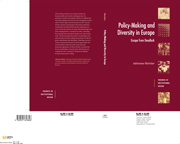Book contents
- Frontmatter
- Contents
- Acknowledgements
- 1 Escaping deadlock: policy-making in Europe
- 2 The context of subterfuge: diversity, fragmentation and the malleability of the European polity
- 3 The analytical approach and theoretical background
- 4 Market-making policy: transport and telecommunications
- 5 The provision of collective goods and the reduction of externalities: environmental policy
- 6 Market-correcting, redistributive policy: regional and social policy
- 7 Market-correcting, distributive policy: research and technology
- 8 Summary and conclusion: stalemate and subterfuge across policy areas
- References
- Index
1 - Escaping deadlock: policy-making in Europe
Published online by Cambridge University Press: 22 September 2009
- Frontmatter
- Contents
- Acknowledgements
- 1 Escaping deadlock: policy-making in Europe
- 2 The context of subterfuge: diversity, fragmentation and the malleability of the European polity
- 3 The analytical approach and theoretical background
- 4 Market-making policy: transport and telecommunications
- 5 The provision of collective goods and the reduction of externalities: environmental policy
- 6 Market-correcting, redistributive policy: regional and social policy
- 7 Market-correcting, distributive policy: research and technology
- 8 Summary and conclusion: stalemate and subterfuge across policy areas
- References
- Index
Summary
Looking at the European polity and European policy developments, one is struck by the contrast between obstacle-ridden decision-making processes, often ending in deadlock, on the one hand, and institutional change and rapid policy movement, on the other. Thus, since the mid-1980s, we have witnessed significant changes, notably in ‘constitution-building, politicisation, mobilisation and enlargement’ (Laffan 1997: 6), and a steady expansion of the European policy agenda (Peters 1996), alongside stalled negotiation processes and incremental policy changes. How can one explain this apparently paradoxical co-existence of stalling and swift development? In this book I contend that gridlock and growth are intimately linked, and that this linkage is derived from two central properties of the European polity – its diversity and its consensual decision-making practices.
In European policy-making, the diversity of actors' interests, the consensus-forcing nature of European institutions and the redistributive elements present in most Community policies would inevitably lead to a stalemate or ‘joint decision trap’ (Scharpf 1991), were it not for the widespread and ubiquitous use of informal strategies and process patterns that circumvent political impasses, referred to collectively as subterfuge or escape routes. Subterfuge then consists of policy strategies and patterns that ‘make Europe work’ against the odds of the given institutional conditions and the enormous diversity of interests.
- Type
- Chapter
- Information
- Policy-Making and Diversity in EuropeEscape from Deadlock, pp. 1 - 5Publisher: Cambridge University PressPrint publication year: 1999
- 6
- Cited by

